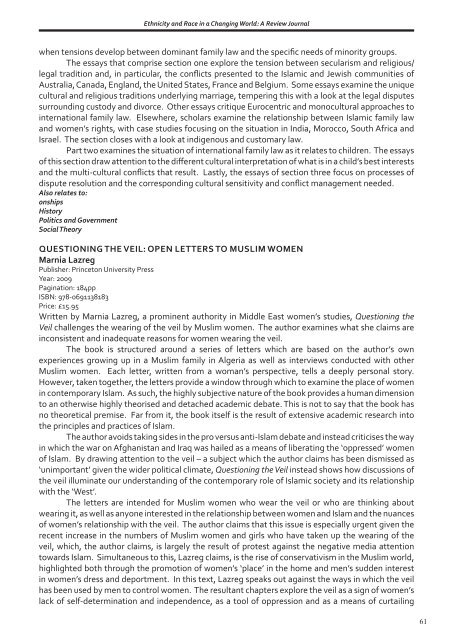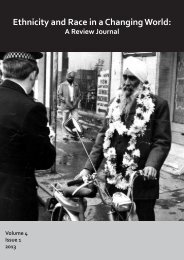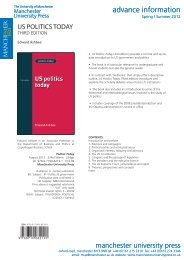Ethnicity and Race in a Changing World
Volume 2, Issue 1, 2010 - Manchester University Press
Volume 2, Issue 1, 2010 - Manchester University Press
- No tags were found...
Create successful ePaper yourself
Turn your PDF publications into a flip-book with our unique Google optimized e-Paper software.
<strong>Ethnicity</strong> <strong>and</strong> <strong>Race</strong> <strong>in</strong> a Chang<strong>in</strong>g <strong>World</strong>: A Review Journalwhen tensions develop between dom<strong>in</strong>ant family law <strong>and</strong> the specific needs of m<strong>in</strong>ority groups.The essays that comprise section one explore the tension between secularism <strong>and</strong> religious/legal tradition <strong>and</strong>, <strong>in</strong> particular, the conflicts presented to the Islamic <strong>and</strong> Jewish communities ofAustralia, Canada, Engl<strong>and</strong>, the United States, France <strong>and</strong> Belgium. Some essays exam<strong>in</strong>e the uniquecultural <strong>and</strong> religious traditions underly<strong>in</strong>g marriage, temper<strong>in</strong>g this with a look at the legal disputessurround<strong>in</strong>g custody <strong>and</strong> divorce. Other essays critique Eurocentric <strong>and</strong> monocultural approaches to<strong>in</strong>ternational family law. Elsewhere, scholars exam<strong>in</strong>e the relationship between Islamic family law<strong>and</strong> women’s rights, with case studies focus<strong>in</strong>g on the situation <strong>in</strong> India, Morocco, South Africa <strong>and</strong>Israel. The section closes with a look at <strong>in</strong>digenous <strong>and</strong> customary law.Part two exam<strong>in</strong>es the situation of <strong>in</strong>ternational family law as it relates to children. The essaysof this section draw attention to the different cultural <strong>in</strong>terpretation of what is <strong>in</strong> a child’s best <strong>in</strong>terests<strong>and</strong> the multi-cultural conflicts that result. Lastly, the essays of section three focus on processes ofdispute resolution <strong>and</strong> the correspond<strong>in</strong>g cultural sensitivity <strong>and</strong> conflict management needed.Also relates to:onshipsHistoryPolitics <strong>and</strong> GovernmentSocial TheoryQUESTIONING THE VEIL: OPEN LETTERS TO MUSLIM WOMENMarnia LazregPublisher: Pr<strong>in</strong>ceton University PressYear: 2009Pag<strong>in</strong>ation: 184ppISBN: 978-0691138183Price: £15.95Written by Marnia Lazreg, a prom<strong>in</strong>ent authority <strong>in</strong> Middle East women’s studies, Question<strong>in</strong>g theVeil challenges the wear<strong>in</strong>g of the veil by Muslim women. The author exam<strong>in</strong>es what she claims are<strong>in</strong>consistent <strong>and</strong> <strong>in</strong>adequate reasons for women wear<strong>in</strong>g the veil.The book is structured around a series of letters which are based on the author’s ownexperiences grow<strong>in</strong>g up <strong>in</strong> a Muslim family <strong>in</strong> Algeria as well as <strong>in</strong>terviews conducted with otherMuslim women. Each letter, written from a woman’s perspective, tells a deeply personal story.However, taken together, the letters provide a w<strong>in</strong>dow through which to exam<strong>in</strong>e the place of women<strong>in</strong> contemporary Islam. As such, the highly subjective nature of the book provides a human dimensionto an otherwise highly theorised <strong>and</strong> detached academic debate. This is not to say that the book hasno theoretical premise. Far from it, the book itself is the result of extensive academic research <strong>in</strong>tothe pr<strong>in</strong>ciples <strong>and</strong> practices of Islam.The author avoids tak<strong>in</strong>g sides <strong>in</strong> the pro versus anti-Islam debate <strong>and</strong> <strong>in</strong>stead criticises the way<strong>in</strong> which the war on Afghanistan <strong>and</strong> Iraq was hailed as a means of liberat<strong>in</strong>g the ‘oppressed’ womenof Islam. By draw<strong>in</strong>g attention to the veil – a subject which the author claims has been dismissed as‘unimportant’ given the wider political climate, Question<strong>in</strong>g the Veil <strong>in</strong>stead shows how discussions ofthe veil illum<strong>in</strong>ate our underst<strong>and</strong><strong>in</strong>g of the contemporary role of Islamic society <strong>and</strong> its relationshipwith the ‘West’.The letters are <strong>in</strong>tended for Muslim women who wear the veil or who are th<strong>in</strong>k<strong>in</strong>g aboutwear<strong>in</strong>g it, as well as anyone <strong>in</strong>terested <strong>in</strong> the relationship between women <strong>and</strong> Islam <strong>and</strong> the nuancesof women’s relationship with the veil. The author claims that this issue is especially urgent given therecent <strong>in</strong>crease <strong>in</strong> the numbers of Muslim women <strong>and</strong> girls who have taken up the wear<strong>in</strong>g of theveil, which, the author claims, is largely the result of protest aga<strong>in</strong>st the negative media attentiontowards Islam. Simultaneous to this, Lazreg claims, is the rise of conservativism <strong>in</strong> the Muslim world,highlighted both through the promotion of women’s ‘place’ <strong>in</strong> the home <strong>and</strong> men’s sudden <strong>in</strong>terest<strong>in</strong> women’s dress <strong>and</strong> deportment. In this text, Lazreg speaks out aga<strong>in</strong>st the ways <strong>in</strong> which the veilhas been used by men to control women. The resultant chapters explore the veil as a sign of women’slack of self-determ<strong>in</strong>ation <strong>and</strong> <strong>in</strong>dependence, as a tool of oppression <strong>and</strong> as a means of curtail<strong>in</strong>g61






